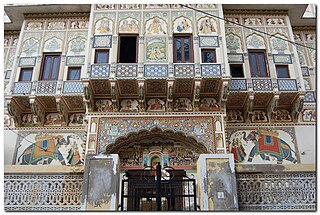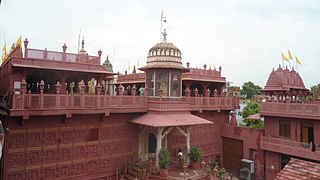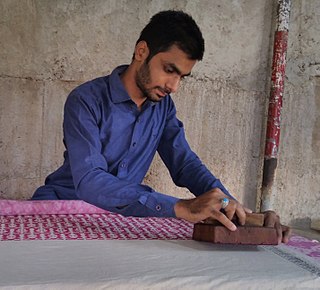
Rajasthan is a state in northern India. It covers 342,239 square kilometres (132,139 sq mi) or 10.4 per cent of India's total geographical area. It is the largest Indian state by area and the seventh largest by population. It is on India's northwestern side, where it comprises most of the wide and inhospitable Thar Desert and shares a border with the Pakistani provinces of Punjab to the northwest and Sindh to the west, along the Sutlej-Indus River valley. It is bordered by five other Indian states: Punjab to the north; Haryana and Uttar Pradesh to the northeast; Madhya Pradesh to the southeast; and Gujarat to the southwest. Its geographical location is 23.3 to 30.12 North latitude and 69.30 to 78.17 East longitude, with the Tropic of Cancer passing through its southernmost tip.

Jaipur, formerly Jeypore, is the capital and largest city of the Indian state of Rajasthan. As of 2011, the city had a population of 3.1 million, making it the tenth most populous city in the country. Jaipur is also known as the Pink City, due to the dominant colour scheme of its buildings. It is also known as the Paris of India, and C. V. Raman called it the Island of Glory. It is located 268 km from the national capital New Delhi. Jaipur was founded in 1727 by the Kachhwaha Rajput ruler Jai Singh II, the ruler of Amer, after whom the city is named. It was one of the earliest planned cities of modern India, designed by Vidyadhar Bhattacharya. During the British Colonial period, the city served as the capital of Jaipur State. After independence in 1947, Jaipur was made the capital of the newly formed state of Rajasthan.
Fatehpur is a city in the Sikar district of Indian state Rajasthan. It is part of the Shekhawati region. It is midway between Sikar city and Bikaner on National Highway 52. It is also the land to Havelis built by Marwari Seth's. It also has many Kuldevi Temples of the Agarwal community for Bajoria,Bindal, Saraf, Chamadia, Choudhary, Goenka, Singhania, Saraogi, Bhartia Families. It is famous for its extreme weather conditions throughout the year. In winters, the minimum temperature falls below 0° Celsius at night for many days making it the coldest town in India in non mountainous region. In summer the temperature rises to 50° Celsius in the afternoon making it one of the hottest places in India. 1985 Bollywood film Ghulami starting Dharmendra, Naseeruddin Shah, Mithun Chakraborty and Smita Patil was extensively shot here in many of its havelis and the railway station.

Mandawa is a town, just 29 km from Jhunjhunu city in Jhunjhunu district of Rajasthan, India. It is part of Shekhawati region. Mandawa is located at 28.05°N 75.15°E. It has an average elevation of 316 metres (1036 ft). The nearest railway station is Jhunjhunu railway station.

Jal Mahal is a palace in the middle of the Man Sagar Lake in Jaipur city, the capital of the state of Rajasthan, India. The palace was originally constructed in 1699; the building and the lake around it were later renovated and enlarged in the 18th century by Maharaja Jai Singh II of Amber.

Bagru is a town and a municipality in Jaipur district in the state of Rajasthan, India. It is located at a distance of 32 km from Jaipur, on Jaipur-Ajmer Road.

Blue Pottery is widely recognized as a traditional craft of Jaipur of Central Asian origin. The name 'blue pottery' comes from the eye-catching cobalt blue dye used to color the pottery. It is one of many Eurasian types of blue and white pottery, and related in the shapes and decoration to Islamic pottery and, more distantly, Chinese pottery.

Samode Palace, Samode Haveli and Samode Bagh (Garden) are heritage monuments and structures built by the noble feudatory with the hereditary title of 'Maha Rawal' or 'Maha Saheb’ of the Amber and Jaipur principality in Rajasthan, India. All three have rich history of several hundred years and display a fusion of Mughal and Rajasthani art and architecture. They are now part of the Heritage group of hotels under the flagship name of "Samode" that are run by the hereditary owners of these structures. The Samode Palace is located 40 kilometres (25 mi) north of Jaipur city, the Samode Haveli is close to Jaipur (centrally located within city limits, 6 kilometres (3.7 mi) away from the city railway station) and the Samode Bagh or Garden, 4 kilometres (2.5 mi) from the palace which is also run as a luxury hotel.

Janet Ann Doub Erickson was an American graphic artist and writer who popularized linoleum-block and woodblock printing in the post-World War II period. She was a co-founder of the Blockhouse of Boston, an innovative art and design cooperative in Boston, Massachusetts. In the preface to her influential book, Block Printing on Textiles, the publisher of a leading arts education magazine noted that, "more than anyone else in America today, Janet Doub Erickson has lifted a craft that had become dull, dead, and dated to a position where we can see its challenging possibilities in the creative renaissance we are now experiencing.”

Sanganer is a town/tehsil situated in Jaipur district, Rajasthan, 16 km south of state capital Jaipur. Jaipur has been divided in 13 Sub divisions and Sanganer is one of these 13 Sub divisions. It is famous for textile printing, handmade paper industry, and for Jain temples. Sanganer prints are one of its own kinds, for the reason that the patterns in bright colours are always printed on white backgrounds. Sanganeri Hand block printing received the geographical indication (GI) tag in 2010.

The culture of Rajasthan includes many artistic traditions that reflect the ancient Indian way of life. Rajasthan is also called the "Land of Kings". It has many tourist attractions and facilities for tourists. This historical state of India attracts tourists and vacationers with its rich culture, tradition, heritage, and monuments. It also has some wildlife sanctuaries and national parks.

Fabindia is an Indian chain store retailing garments, home-decor, furnishings, fabrics and products handmade by craftspeople across rural India. Established in 1960 by John Bissell, an American working for the Ford Foundation, New Delhi, Fabindia started out exporting home furnishings, before stepping into domestic retail in 1976, when it opened its first retail store in Greater Kailash, New Delhi. The chairman of the company is John's son, William Nanda Bissell. As of July 2020, Fabindia operated 327 stores across India and 14 international stores.

Rajasthan is one of the most popular tourist destinations in India, for both domestic and international tourists. Rajasthan attracts tourists for its historical forts, palaces, art and culture with its slogan "Padharo Mhare Desh". Jaipur, is also known as Pink City, is a very popular tourist destination, being the capital of Rajasthan and a part of the Golden Triangle. The Walled City of Jaipur is a UNESCO World Heritage Site and is only the second Indian city to be recognized, after Ahmedabad.

The City Palace, Jaipur is a royal residence and former administrative headquarters of the rulers of the Jaipur State in Jaipur, Rajasthan. Construction started soon after the establishment of the city of Jaipur under the reign of Maharaja Sawai Jai Singh II, who moved his court to Jaipur from Amber, in 1727. Jaipur remained the capital of the kingdom until 1949—when it became the capital of the present-day Indian state of Rajasthan—with the City Palace functioning as the ceremonial and administrative seat of the Maharaja of Jaipur. The construction of the Palace was completed in 1732 and it was also the location of religious and cultural events, as well as a patron of arts, commerce, and industry. It was constructed according to the rules of vastushastra, combining elements of Mughal and Rajput architectural styles. It now houses the Maharaja Sawai Man Singh II Museum, and continues to be the home of the Jaipur royal family. The royal family has around 500 personal servants. The palace complex has several buildings, various courtyards, galleries, restaurants, and offices of the Museum Trust.The MSMS II Museum Trust is headed by chairperson Rajamata Padmini Devi of Jaipur. Princess Diya Kumari runs the Museum Trust, as its secretary and trustee. She also manages The Palace School and Maharaja Sawai Bhawani Singh School in Jaipur. She founded and runs the Princess Diya Kumari Foundation to empower underprivileged and underemployed women of Rajasthan. She is also an entrepreneur. In 2013, she was elected as Member of the Legislative Assembly of Rajasthan from the constituency of Sawai Madhopur.

The Albert Hall Museum in Jaipur is the oldest museum of the state and functions as the state museum of Rajasthan, India. The building is situated in Ram Niwas garden outside the city wall opposite New gate and is a fine example of Indo-Saracenic architecture. It is also called the Government Central Museum. It was considered one of the best 19th century museums for the variety of its collections. It was renovated in 2008 and reopened as one of the most advanced museums in India.

The crafts of India are diverse, rich in history, culture and religion. The craft of each state in India reflect the influence of different empires. Throughout centuries, crafts have been embedded as a culture and tradition within rural communities.

Bagh print is a traditional Indian handicraft originating in Bagh, Dhar district of Madhya Pradesh, India. The process is characterised by hand printed wood block relief prints with naturally sourced pigments and dyes. Bagh print motifs are typically geometric, paisley, or floral compositions design, dyed with vegetable colours of red and black over a white background, and is a popular textile printing product. Its name is derived from the village Bagh located on the banks of the Bagh River.

Abdul Kadar Khatri (1961–2019) was an Indian master craftsman in the sector of traditional hand block printing known as Bagh Print. He was the son of Ismail Sulemanji Khatri, founder of Bagh print. He along with his father saved the tradition of Textile printing of Bagh from extinction and taken it to new heights. His artifacts have brought laurels to India and particular to Madhya Pradesh state from across the globe by showcasing his exceptional talent in Bagh Print in many countries. His family has been working in the trade of Traditional Bagh Hand Block print since the 7th century.
The Sardar Government Museum is located in Public Park, Jodhpur, Rajasthan, India. The museum is named in memory of Maharaja Sardar Singh, a ruler of Jodhpur from 1895 to 1911. It was constructed under the reign of his son, Maharaja Umed Singh. It was built by Henry Vaughan Lanchester in 1909 and formally opened to the public on 17 March, 1936. The area of the museum is approx. 18,000 sq.ft. On 22 June 2018, the re-planned museum was inaugurated by Smt. Vasundhara Raje, the Chief Minister of Rajasthan.
Anokhi is an Indian retailer based in Jaipur, Rajasthan, which retails textiles, clothing, furnishings, and accessories, made with traditional Indian motifs and techniques. It was founded in 1970 by husband and wife, John and Faith Singh, with a focus on reviving traditional Rajasthani hand-block or woodcut printing techniques, and the use of natural vegetable dyes. Anokhi works directly with Rajasthani craftspeople, and retails through its 25 stores in India and a few stockists in Europe and the United States.

















